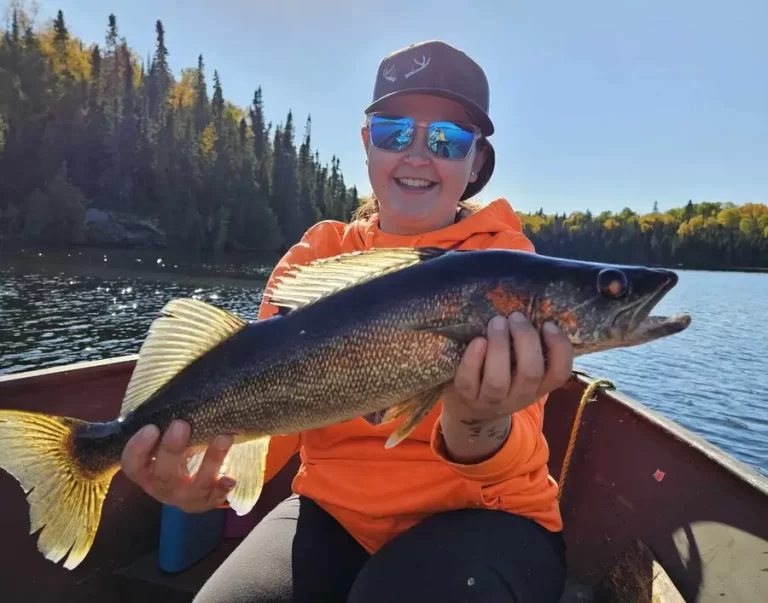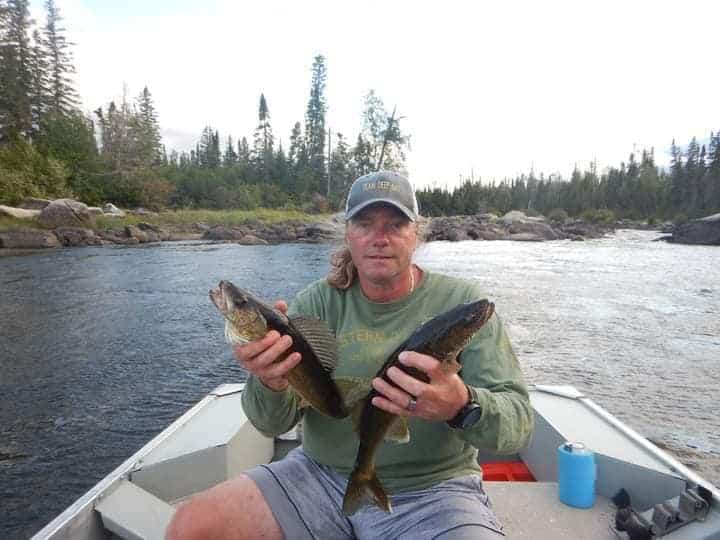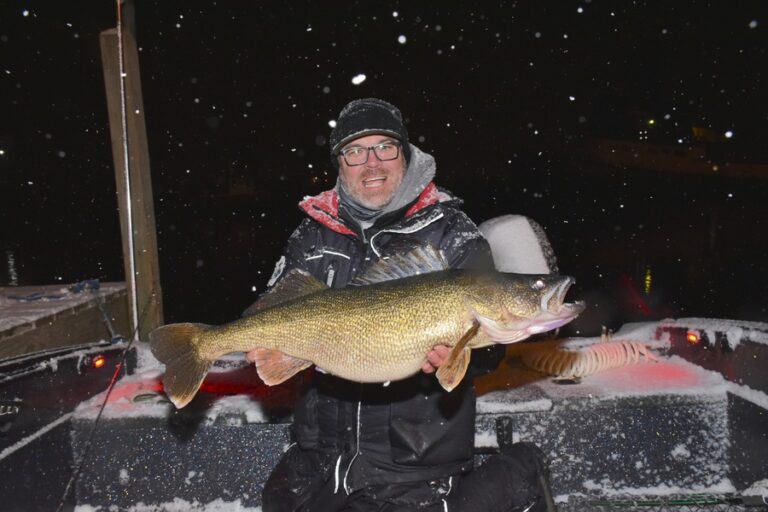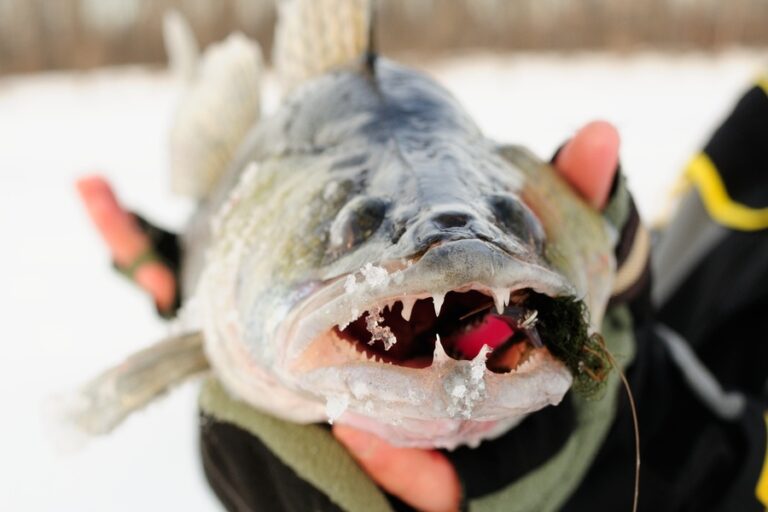Catching Walleye in Cold Weather (All Seasons Guide)
In colder water temperatures, often below 50°F, walleye are usually found in deeper zones or near river mouths where the water remains consistently cold and baitfish are likely to school.
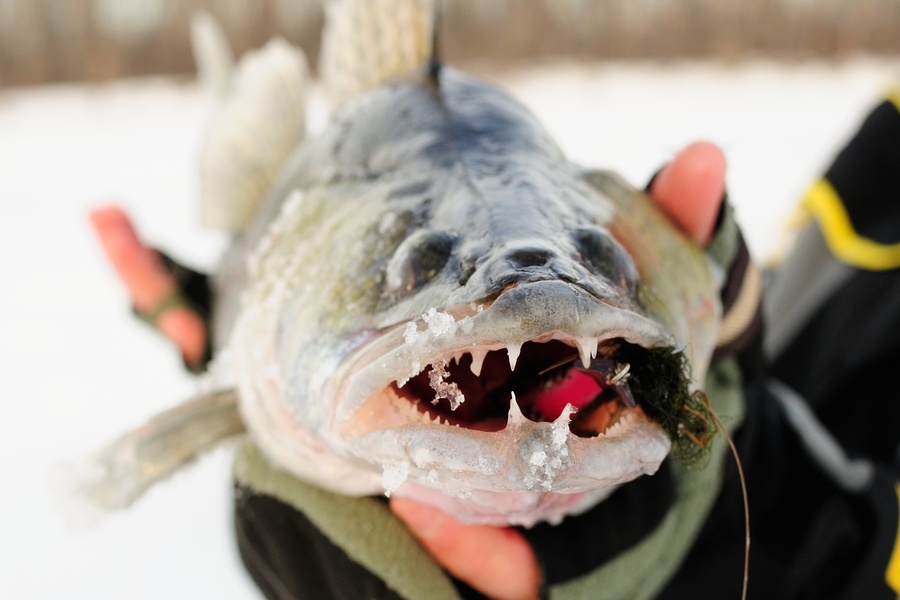
Table of Contents
Locations: Catching Walleye in Cold Weather
Walleye respond to cold breaks in the weather differently each season. If the weather has been hot, cooler temperatures will lift walleye up in the water column and closer to shore. Look for walleye in 10-20 feet of water near inside turns and make lake points.
If the normal temps are already frigid, an extreme cold spell can completely shut down the bite and force walleye down to the deepest main lake or river holes. Really cold temps result in walleye often with their bellies resting right on the bottom, trying to find the warmest water possible.
Table: Where to Find Walleye Based on Temperature
| Air Temperature Range (°F) | Water Temperature Range (°F) | Likely Walleye Location | Suggested Fishing Methods |
|---|---|---|---|
| Below 32 (Freezing) | Under 40 | Deep holes, river inlets | Vertical jigging with live bait, spoons |
| 32 to 50 | 40 to 49 | Shallow flats in the daytime, deeper waters when cooler | Jigging with minnows, crankbaits |
| 50 to 68 | 50 to 59 | Transition areas, near spawning grounds | Light jigs, crankbaits, jerkbaits |
| 68 to 80 | 60 to 69 | Weed lines, rocky points | Spinners, trolling with crankbaits |
Click here to learn how weather impacts walleye fishing. To learn how to catch walleye on sunny days, check out this guide. To learn how to catch walleye on snowy days, check out this guide.
Seasonal Guide to Cold Weather Walleye Fishing
Table: Seasonal Impacts of Cold Walleye Fishing
| Season | Cold Weather Fishing for Walleye | Tips and Techniques |
|---|---|---|
| Spring | Early spring can still be quite cold, especially in northern regions. Walleye start moving towards shallow waters for spawning. | Focus on shallow bays and river mouths. Use jigs and minnows for spawning walleyes. |
| Summer | Summer typically doesn’t have cold weather, but early mornings and late evenings can be cooler. | Fish deeper waters where it’s cooler. Use deep-diving crankbaits and bottom bouncers. |
| Fall | Fall sees a drop in water temperatures, making it a great season for walleye. They become more active in shallower waters. | Troll with crankbaits in shallower waters. Jigging over deep structures can also be effective. |
| Winter | Ice fishing becomes the primary method. Walleye tend to move to mid-range depths. | Use ice fishing techniques like jigging with live bait. Focus on areas with structures or drop-offs. |
Winter
In winter, walleye slow way down and their feeding diminishes some. They are still very catchable, especially through the ice though. They will be in deeper holes and main lake basins where two types of bottoms transition (ex: sand to gravel).
The cold weather will push them down deeper often resting with their bellies right on the bottom. Look for pockets of walleye 20-35 feet down. Very cold weather can feature great walleye fishing in early winter right after first ice coverage. Walleye will focus on schooling bait like shiners, perch, alewives, and smelt.
Spring
Walleye fishing can be really good in spring, especially right after ice melt. Walleye will push into northern shallow bays near feeder streams and feed heavily to prepare for the upcoming spawn.
Look for shallow northern bays in large lakes and rivers with a gravel or mud bottom with the first growing vegetation of the year. Extra points if you find a nice gravel bottom stream mouth nearby.
Walleye will be in 5-15 feet of water for much spring. A cold front can push walleye back into deeper water away from the bay down to about 30 feet until the cold passes. A spring cold front can slow down fishing but it should pick up once the weather starts to warm back up.
Summer
Typically walleye move to deep water in summer to avoid the heat. A cold snap can turn the walleye bite on, moving them to shallower water. Look for schools of walleye over rocky or weedy areas in 15-25 feet of water.
These areas are excellent if there is deep water nearby. Fishing during these summer cooling spells will be best at dawn and dusk.
Fall
On cooler days in fall, focus on transitional zones in 10-20 feet of water where rock meets mud or sandy bottoms. Features that attract walleye are ledges, sandbars, and deep weed edges. Rock piles are great spots too. Fishing is excellent in early and mid-fall.
A cold front can really amp up the urgency for walleye to pack on weight to prepare for winter. Larger baitfish like gizzard shad, alewives, and perch are preferred.
How Cold Impacts Walleye Through the Day
Morning
Colder temperatures in the morning will push walleye into shallower waters. Fish near main and secondary lake points with rock or sandy spots nearby in 5-15 feet of water. Dropoffs and inside turns are great spots too.
Afternoon
Typically the warmest part of the day, walleye will want cooler waters found down deep. But a colder day will see walleye remain higher in the water column or moving closer to shallow bays and points. Focus on 10-20 feet of water near submerged structure like rock, ledges, and humps.
Evening & Night
Cooling temperatures of the late evening and nighttime push walleye up shallower. But if temperatures are unseasonably cold, walleye will likely stay deeper in more comfortable water.
I fish in water 15-30 feet on colder evenings, regardless of the season. Baitfish will be active and moving around submerged structure like rock and ledges.
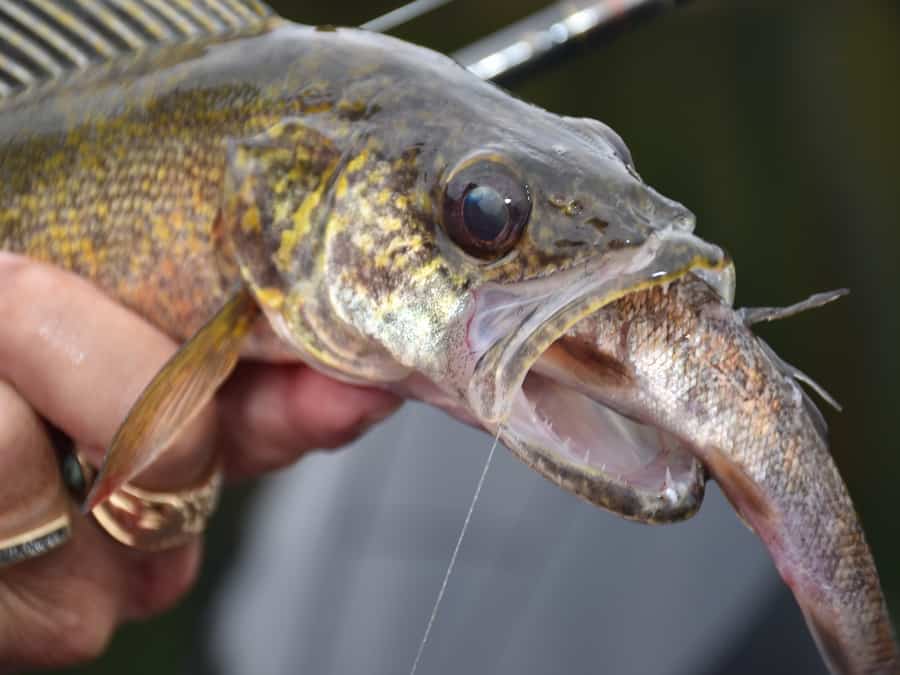
Slow Presentations for Cold Walleye Fishing
When fishing walleye in cold weather, it’s important to slow way down. If fishing with a jig, let the jig touch bottom then pop it occasionally. If fishing over sand, mud, gravel, and even small rock, you won’t have to worry about snagging up and losing your bait.
Fishing with spoons and crankbaits, a slow steady retrieve with pauses or “stalls” can work great. I would recommend against any fast or erratic actions in cold weather. Those rarely catch much walleye in cooler weather.
Table: Cold Weather Walleye Fishing
| Technique | Description | Why It Works for Cold Weather Walleye |
|---|---|---|
| Slow Trolling | Trolling at a slower speed than usual to match the reduced activity level of walleye. | Mimics the slower movement of baitfish in cold weather, appealing to less active walleye. |
| Vertical Jigging | Dropping a jig vertically in the water and gently jigging it up and down. | Effective for reaching walleye near the bottom, where they tend to be in cold weather. |
| Ice Fishing with Jigs | Using small jigs beneath the ice, often paired with live bait like minnows. | Allows targeting walleye in deeper waters, common during the cold months. |
| Dead Sticking | Leaving a baited hook or jig motionless in the water, often near the bottom. | Capitalizes on the walleye’s passive feeding habits in colder temperatures. |
| Lindy Rigging | Using a rig that allows live bait to move naturally with minimal resistance. | Great for a natural presentation of bait, crucial in clear, cold water. |
| Slip Bobber Fishing | Using a bobber to suspend bait at a specific depth, adjusting for where walleye are located. | Effective for precise bait placement in deeper spots where walleye congregate in cold weather. |
| Casting with Soft Plastics | Using soft plastic lures with a slow retrieval to mimic lethargic prey. | Soft plastics’ subtle movement can provoke strikes from sluggish walleye. |
| Spooning | Jigging a spoon lure vertically, creating a fluttering motion. | The erratic action of a spoon can trigger aggressive strikes from walleye. |
| Bottom Bouncing | Dragging a weighted rig along the bottom to stir up sediment and attract fish. | Effective in catching walleye that are hugging the lake or riverbed in cold weather. |
| Casting with Crankbaits | Using crankbaits with a slow, steady retrieve to mimic the movement of cold-weather baitfish. | Lifelike swimming action can attract walleye, especially in clearer waters. |
Cold Weather Walleye Tips
- Slow Down Your Retrieval: In cold water, walleye metabolism slows down. Therefore, a slower retrieval rate can be more effective as walleye are less likely to chase fast-moving baits.
- Use Smaller Baits: Smaller lures or baits often work better in cold weather since walleye prefer smaller, easier-to-catch prey during this time.
- Vary Your Jigging Technique: Instead of a steady jigging motion, try varying your technique with pauses and slower lifts, as this can be more enticing to lethargic walleye.
- Fish During Stable Weather Patterns: Look for periods of stable weather. Sudden changes in weather can disrupt walleye feeding patterns.
- Focus on Late Afternoon: In cold weather, the late afternoon is often the warmest part of the day, potentially increasing fish activity.
- Use Lighter Line: A thinner, less visible line can be more effective in the clear, cold water often found during winter months.
- Experiment with Scented Baits: Adding scent to your lures or using scented baits can make them more appealing, as walleye rely more on smell in murky or dark winter waters.
- Target Sunlit Areas: Areas that receive more sunlight can be slightly warmer and more attractive to baitfish, and in turn, to walleye.
- Fish Near the Bottom: Walleye often stay close to the bottom in cold weather, so lures and baits should be presented near or on the bottom.
- Look for Areas with Minimal Current: In rivers, walleye often prefer areas with less current during cold weather, as it requires less energy to stay in these spots.
- Use a Deadstick Technique: In addition to jigging, try using a deadstick (a rod set up with a live bait and left stationary) to appeal to less active fish.
- Monitor Barometric Pressure: A rising barometric pressure can often lead to increased walleye activity in cold weather.
- Fish Around New Ice: In early winter, the area around new ice can be particularly productive, as it often holds more oxygen and attracts baitfish.
- Pay Attention to Underwater Structures: Focus on areas with structures like drop-offs, rock beds, or submerged objects, as walleye tend to congregate around these in cold weather.
Conclusions
When it’s cold, especially in the late evening or at night, walleye rise up to shallower waters in the 10-25 foot range. Fish around rocks or ledges as these draw in bait and walleye in colder temps.
In winter, walleye will rest right on the bottom in deep water to find warmer water. Remember, when the water’s chilly, you have to fish slow. Walleye will be sluggish and very cold themselves. They won’t exert much energy chasing down fast-moving food.

